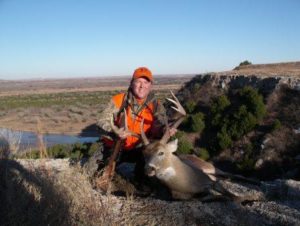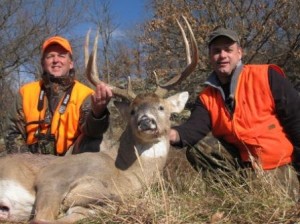 At first I figured some guy on the next ridge had spooked the jittery doe that dashed past my stand. But then I had a premonition: Was something more happening here? I readied my .270, just as the 9-pointer prowled forth, grunting with his nose to the ground. Easy shot.
At first I figured some guy on the next ridge had spooked the jittery doe that dashed past my stand. But then I had a premonition: Was something more happening here? I readied my .270, just as the 9-pointer prowled forth, grunting with his nose to the ground. Easy shot.
That would have been your classic rut hunt, except for one thing. I killed that gnarly buck on a cold day in late December, a good month after the breeding season had peaked in Virginia.
Understanding the Second Rut
Many hunters think the rut is confined to 2 or 3 weeks in mid-November, but it’s not. There is more “trickle breeding” going on into December than you might imagine.
Bucks cannot impregnate all of a herd’s does during the main event in November, especially in places where the sex ratio is out of whack–say one mature buck for 6 or more does. There aren’t enough studs to service all those gals. Does missed by the bucks enter a second estrus cycle in December some 24 to 28 days after the peak rut.
Contributing to the late or second rut is the puberty of doe fawns. In regions where food is abundant and nutritious, notably Midwest farm country, some 6- and 7-month-old does may be ready to breed in December.
When those recycling does and fawns begin swirling a second wave of estrus scent, the woods will once again erupt with wild-eyed, tongue-lolling bucks, right? Wrong. As compared to the frat-party atmosphere of the main rut, the late show is like a black-tie affair. Males and females commingle, but in a more subdued manner. Heck, many years you won’t see any visual signs of late-rutting activity.
But it’s happening—get out there and use these tactics to score a late-rut buck.
Back to Scrapes
Go back and check the biggest, most active scrape sites you found in late October and November with big rubs nearby. Some bucks re-check and hang around scrape/rub zones where they hooked up with hotties in the first rut.
But now work a key ingredient—cover—into your strategy. Any big deer that survived a hail of arrows and bullets will re-check scrapes that are located in or around thick security cover.
Don’t hunt over the scrapes per se, but hang a stand and watch the edges of thick cover where you might catch a buck prowling around the scrapes.
Hang with a Hot Doe
One December day in Kansas, Jim Riley spotted a doe being dogged by three bucks, but the brush was too thick for a shot. Jim returned the next morning. The doe came back through followed by 5 bucks this time, but none was a shooter. Jim hung tough in the stand, and on the third morning the doe was back with only one buck. Jim nailed the giant 8-pointer (see picture).
In December just one hot doe in a patch of woods will draw different bucks sniffing around for one last shot of fun. As long as she hangs around, you hang around until a shooter shows up.
Use Deer Scents
One December day in Kansas B.J. Clement and his son, Todd, dug mock scrapes and laid scent trails with both estrus doe and dominant buck through an area where they knew good bucks hung out.
“When my dad went in to hunt on Saturday afternoon a buck had torn the place to pieces with huge rubs and scrapes,” Todd says.
That evening a big buck started for B.J.’s blind, but he spotted a doe and took off after her. Minutes later, B.J saw the buck again. He rubbed a hedge tree, and then walked in. B.J. fired a perfect arrow. The 12-pointer netted 182, one of the top bow bucks of 2009!
The takeaway: That monster was still rutting hard, checking does and rubbing trees. The Clements’ doe/buck scent strategy, which created the illusion of a late breeding zone, caused the big deer to hang in the area until B.J got him. Try that.
Shoot a Doe—Then Your Buck
I’ve saved the most radical new tactic for last.
“We often harvest a doe, with either bow or gun, and remain in the stand,” says noted Missouri biologist Dr. Grant Woods. “The smell of an adult doe in the receptive stage late in the season is a great attractant for mature bucks. I’ve shot several bucks that came in to sniff the doe I had shot earlier in the hunt. Even the disturbance of a rifle shot didn’t matter. I realize this is contrary to popular belief, but it works.”
Be sure you have the proper tags, and that shooting a buck and a doe on the same day is legal.
That’s a cool way to fill the freezer at the buzzer of the season.






